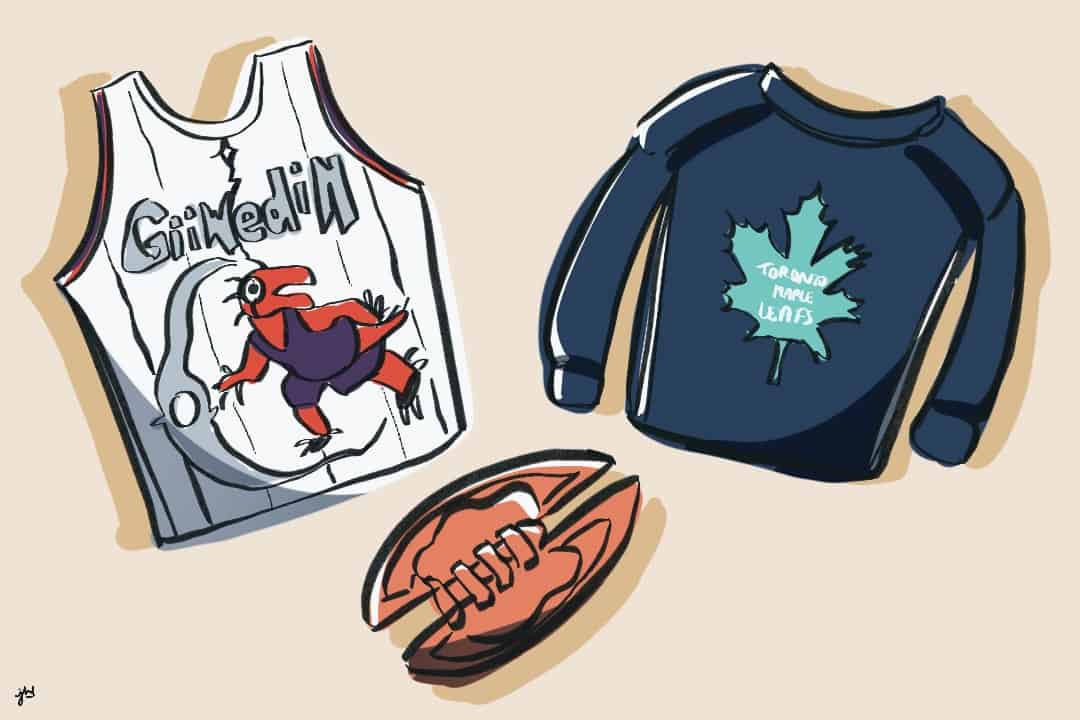Think of your favourite team, picture it in your head. What aspect of the team comes to mind — is it your favourite player? A championship moment? The head coach? Now think about the colours that surround that memory, the vibe it gives off. Chances are, you’ll end up picturing that team’s logo during this exercise.
Logos are a key part of any team’s identity, whether it be the Golden State Warriors with their classic yellow and blue or the Toronto Maple Leafs with their iconic blue and white. But every now and then, a team will make a statement jersey.
Lately, multiple Toronto teams have used the hype surrounding their jerseys to put artists from marginalized communities on the big stage. For The Varsity’s Indigenous issue, we looked into some of Toronto’s Indigenous-themed jerseys and figured out the leaders behind the logos.
Last year, the Toronto Raptors three-point connoisseur Fred Van Vleet teamed up with Indigenous artist Mike Ivall and illustrator Casey Bannerman to make a red, blue, and purple masterpiece for the National Day of Truth and Reconciliation. The jersey touches on the Raptors’ famous slogan “We The North”’ with the word “Giiwedin” at the front, which means “North” in Ojibwe. A portion of the proceeds from the jersey sales went to the Orange Shirt Day Society.
The special Raptors jersey was designed by artist Norval Morrisseau, a member of the Bingwi Neyaashi Anishinaabek First Nation, is credited as being the ‘Picasso of the North.’ Morrisseau emphasizes the outlines of people, creatures, and objects, alongside bright colours, in his artwork. The Raptors jersey features; it reflects the work of Morrisseau, who is the credited creator of the ‘woodland’ style of art.
Basketball is not the only sport in Toronto to embrace and celebrate Indigenous cultures. The Toronto Maple Leafs commissioned Anishinaabe artist Tyler Tabobondung Rushnell to create a new cover of the Leafs’ jersey, which features a revamped maple leaf with a thunderbird shoulder patch. Taking inspiration from the Ojibwe and the Anishinaabe peoples, the thunderbird represents strength and symbolizes the fierce nature of Toronto’s defensive hockey team.
The proceeds from the sale of these jerseys were donated to the Toronto Council Fire Native Cultural Centre. The Maple Leafs sent out a tweet that read: “Recognizing and celebrating Indigenous people’s contribution to hockey and sport and culture today.”
Meet Tyler Tabobondung Rushnell, the artist behind our Indigenous Celebration game warm up jersey & logo pic.twitter.com/F3SCJHtAQc
— Toronto Maple Leafs (@MapleLeafs) January 6, 2023
Both the Leafs and the Raptors are contemporary examples of a push for inclusivity from sports teams. This push for inclusivity is that much more meaningful when displayed on logos that are broadcasted to screens across the world. It’s important to realise that the “we” in the Raptors slogan “We the North” is composed of many different people from different walks of life, and they should be celebrated accordingly.
While woodland style jersey art is a start toward inclusivity in sports, there is still a long way to go. A proper follow up to the Truth and Reconciliation Committee’s Call to Actions 87–91 is needed in order for Indigenous athletes to properly be represented in Canada. Specifically, following through on the National Indigenous Sport Strategy, as well as providing funding for Indigenous athletic development programs, are both needed to take strides in the right direction.


